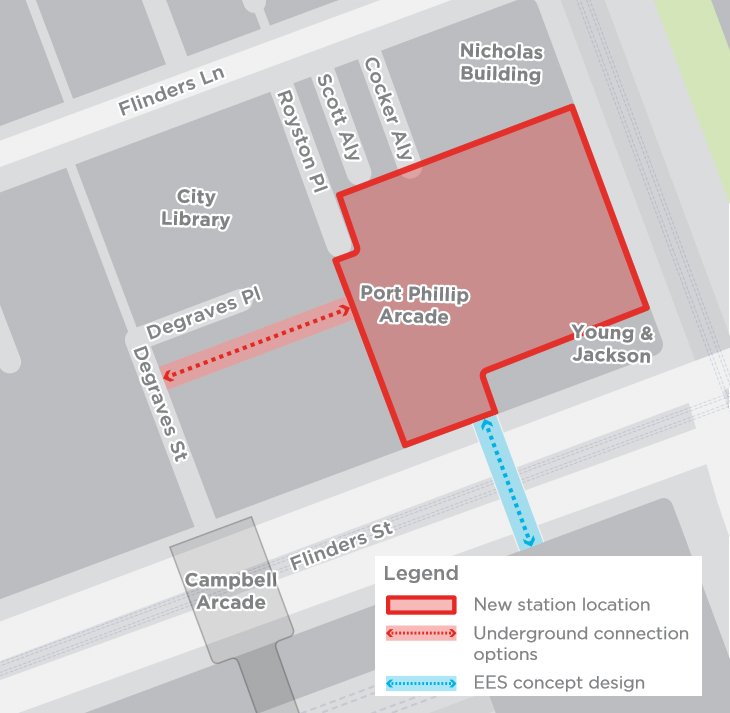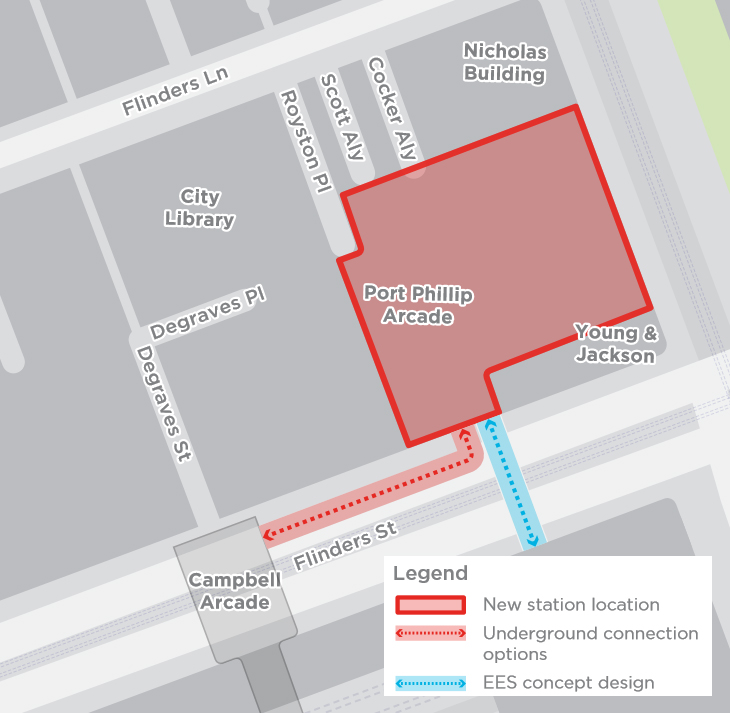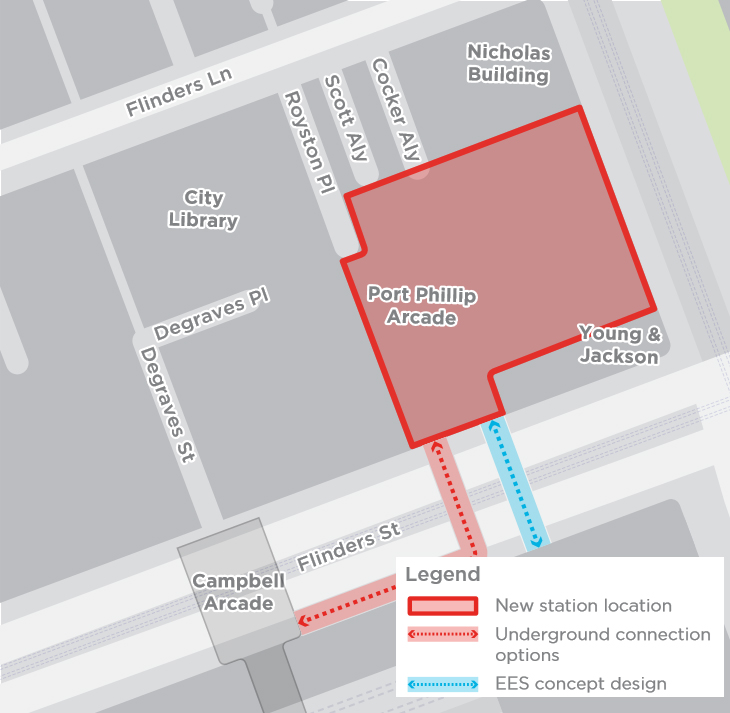Draft Development Plans for the Station Precincts were available for public display and comment from Monday 27 November to Friday 15 December 2017.
As part of the updated Development Plan submission to the Minister for Planning, Cross Yarra Partnership (CYP) has provided all written comments received during the stakeholder and community consultation undertaken in late 2017.
In total, 1507 submissions were received. The key issues raised in feedback received included:
- bicycle routes and parking
- tree removal and replacement
- car parking
- ventilation structures
- design of the City Square and Federation Square station entrances
- the passenger connection between Town Hall Station and Flinders Street Station.
Cross Yarra Partnership response
This page outlines how feedback on these key issues has been addressed by Cross Yarra Partnership in the Development Plans submitted to the Minister for Planning.
Detailed design will continue during project delivery, with CYP to prepare approximately 450 Design Packages that relate to specific technical disciplines and geographic areas. In accordance with the project contract, Design Packages are reviewed by the project delivery authority and the Independent Reviewer, and subject to specified consultation with relevant stakeholders such as relevant council/s, the Office of Victorian Government Architect (OVGA), VicRoads, Metro Trains Melbourne and Yarra Trams.
In the event that the scope and extent of the built form of CYP's works change during detailed design or as a result of heritage approval requirements, an amendment to the Development Plan would be prepared and approval sought from the Minister for Planning.
Bicycle routes and parking
The design of the precincts surrounding the new Metro Tunnel stations rebalances the urban realm towards greater active transport use, creating an inviting and safe pedestrian and cycling environment.
This has been achieved through the provision of wider footpaths with improved pedestrian amenity, as well as new bicycle lanes and cycling facilities at the new stations with ample bicycle parking.
Across the Metro Tunnel Project, bicycle lanes will be provided in accordance with the relevant design standards and, in some cases, will exceed these standards.
Arden precinct
The location and planned revitalisation of the Arden precinct around the station provides the opportunity to develop a high quality active transport network.
To prioritise cyclists, the precinct will reinstate bicycle lanes on Laurens Street, providing access from the surrounding network to the station. 126 bicycle parking spaces will be provided when the station opens.
Parkville precinct
The proximity of Parkville Station to the University of Melbourne, hospitals and research institutions provides the opportunity for integration of cycling facilities with the surrounding environment.
Dedicated bicycle lanes along Royal Parade and Elizabeth Street will be maintained throughout project works. These existing lanes will connect to new Grattan Street bicycle lanes constructed as part of the works. To improve safety, Grattan Street cycle lanes will be 1.8m in width, which meet minimum standard requirements and are consistent with Royal Parade and Elizabeth Street lanes.
Aligning with the vision for the Parkville precinct, Grattan Street will evolve from a private vehicle thoroughfare to a low speed, pedestrian promenade with improved interchanges between buses and trains.
The combined width of the vehicle parking bay, associated parking buffer and bike lane alongside bus bays will be greater than 5m.
One lane of traffic (suitable for emergency vehicles) will be retained in each direction, with wider pedestrian footpaths and kerbside parking for service vehicles and buses on either side.
260 bicycle parking spaces will be provided when the station opens.
CBD North and CBD South precincts
CBD North (State Library Station) and CBD South (Town Hall Station) precincts are located along Swanston Street, a heavily utilised cycling route. While the project does not impact this existing cycle infrastructure, it does propose a number of changes to improve cyclist accessibility.
The CBD North precinct will feature new cycling lanes on Franklin Street, a significant improvement compared to the current cycling infrastructure available on this east-west route. 72 bicycle parking spaces will be provided when the station opens.
The CBD South precinct proposes few changes to the existing cycling infrastructure due to the heavily constrained existing conditions. 74 bicycle parking spaces will be provided when the station opens.
Domain precinct
Anzac Station is strategically placed to ease pressure on the St Kilda Road / Swanston Street tram corridor, which is the busiest tram corridor in the world. It will feature a convenient, direct train / tram interchange on St Kilda Road.
St Kilda Road is also one of Melbourne’s busiest cycling routes. The design of bicycle lanes in the Domain precinct has been developed to integrate into the existing bicycle network along St Kilda Road and the wider precinct. If a future decision is made regarding a preferred bicycle lane layout, CYP will make changes based on a direction from the State.
The St Kilda Road bike lanes will be between 2.5m and 2.9m in width. This will reduce to 2m along the reconfigured Albert Road to accommodate the kerb line and street trees.
126 bicycle parking spaces will be provided when the station opens.
Tree removal and replacement
The Metro Tunnel Project will revitalise public space and increase tree numbers.
To deliver a major project of this scale and complexity, some tree removal is required to allow the safe construction of stations and associated infrastructure.
The project is committed to protecting and retaining as many trees as possible. The design process considers any tree impacts on an individual – tree by tree – basis and methodologies are adjusted wherever possible to protect trees. The Project’s overall objective is to double tree canopy across the entire Metro Tunnel Project.
Through focused efforts, the number of trees required for removal compared to the Environment Effects Statement (EES) has already been reduced from 928 to 771 across all precincts. We are confident the number of trees required will reduce further during project delivery.
Where trees need to be removed, pre-clearing inspections are carried out to identify any wildlife and wildlife carers will be present.
Tree removal is subject to the processes outlined in the approved Environmental Management Framework and approval processes under the Heritage Act 2017.
As detailed design progresses, the precise tree species to be reinstated will be reviewed in consultation with councils and Heritage Victoria.
Arden precinct
In the Arden precinct, particular attention has been given to retaining as many mature trees as possible, such as those along Laurens Street. As part of construction works, 105 trees will be removed, 17 less than identified in the EES. The remaining River Red Gum will be protected throughout the works.
The design for the Arden precinct includes reinstating trees throughout the precinct, in consultation with the City of Melbourne. Overall there will be approximately 98 new trees planted within the Arden precinct.
Parkville precinct
In Parkville, 198 trees will be removed for the project, which is 31 more than identified in the EES. These additional trees will need to be removed for changes to the station design including a new station entrance on Royal Parade to service the Royal Melbourne Hospital, and the nature and location of services within the university grounds. During the detailed design process, opportunities will be sought to reduce the number of trees to be removed on Royal Parade and on the University of Melbourne campus.
The legacy design of the project retains the precinct’s strong landscape character, including more trees on Grattan Street and reinstating the Royal Parade heritage boulevard trees, in consultation with Heritage Victoria. Overall there will be approximately 212 new trees planted across the precinct.
CBD North precinct
As part of construction works, 57 trees will be removed. The project design will transform Franklin Street into a tree lined boulevard and A’Beckett Street into a pedestrianised green space for community use. Overall there will be approximately 95 new trees planted across the precinct.
CBD South precinct
As part of construction works, 30 trees will be removed. Tree removal in the precinct is concentrated in City Square and along Swanston Street adjacent to the station entry between Flinders Street and Flinders Lane. Trees will be reinstated in City Square and along Swanston Street as part of the project design. Overall there will be approximately 34 new trees planted across the precinct.
Domain precinct
The Metro Tunnel Project recognises the cultural and historic importance of the trees on St Kilda Road and in Albert Road Reserve.
The detailed design and review process has reduced the number of trees impacted in the Domain precinct (including St Kilda Road) from 224 to 170. This includes reducing the number of trees required to be removed on St Kilda Road from 169 in the EES to 94, a reduction of 45%. 75 trees are now not impacted along the heritage listed boulevard.
In Albert Road Reserve, the Windsor Oak has been retained as have many of the existing Elm trees. Overall there will be approximately 233 new trees planted across the precinct.
Changes to car parking
The Metro Tunnel Project is designed for the long-term transport requirements of Melbourne, creating capacity on the network to enable 39,000 more passengers from Day One of operations to use the rail system during each peak period.
There will be permanent removal of some car parking spaces across the project to facilitate the delivery of this city-shaping project.
Arden precinct
The new Arden station will be a catalyst for urban renewal, providing improved public transport links to Melbourne’s CBD and surrounding suburbs.
The project design provides car parking spaces along Laurens Street and Barwise Street. A new service laneway created off Barwise Street will service the back of house areas of the station.
Transport interchange integration ensures easy passenger arrival from taxi or car drop-off. Within the Arden precinct, approximately 34 car parking spaces will be removed.
Parkville precinct
In Parkville, the heart of Melbourne’s world-class hospital, research and education precinct, the project design provides priority to emergency vehicles and disability access.
Enhanced connections between train, tram and bus routes will be created, including the provision of new stops and platforms which have been integrated into the design of Grattan Street and Royal Parade. As part of the design, Grattan Street will become a more pedestrian-friendly environment with wider footpaths.
The design of Parkville Station further enhances this with a station entry on the northeast side of Royal Parade providing direct interchange with the Royal Parade tram stop.
Within the Parkville precinct, approximately 152 car parking spaces will be removed.
CBD North precinct
The project design includes limited permanent changes to the road network. The needs of service/emergency vehicles and DDA requirements have been considered in the design of the CBD North precinct. Service vehicle bays for loading and waste have been provided on Franklin, Little La Trobe and Swanston Streets. DDA parking is provided outside City Baths and near both station entries.
CBD South precinct
The project design includes limited permanent changes to the road network. Traffic demand in the Melbourne CBD has been relatively static over recent years and future traffic growth in and around the precinct is expected to be close to zero. The needs of service, emergency vehicles and DDA requirements have been taken into consideration in the design. Loading bays have been provided at strategic locations near retail facilities. Emergency vehicle access and DDA parking will also be provided within the precinct.
Domain precinct
Anzac Station connects the Domain precinct to the rail network for the first time. The design allows commuters to directly interchange between trains and trams, and to access the station via a walkway without having to cross vehicle lanes.
Within the Domain precinct, approximately 211 car parking spaces (90 from St Kilda Road, and 121 from Albert Road) will be removed.
The Domain precinct design will also deliver a new neighbourhood green park, providing a connection between Albert Park, the Shrine Reserve and Kings Domain.
Ventilation structure
Ventilation shafts and chiller plants are common and necessary infrastructure in cities and play an important part in keeping our transport networks moving. Melbourne currently has a number of ventilation shafts and chiller plants in operation, servicing our existing train and road tunnels.
Safe operation of the Metro Tunnel requires ventilation shafts and chiller plants to be constructed along the alignment. These structures are typically located near stations.
Air quality
The trains running through the Metro Tunnel are electric and do not make emissions that could impact on human health or the local environment.
The Metro Tunnel ventilation shafts will not emit visual or sensory pollutants during normal operation. On a day-to-day basis ventilation shafts assist with balancing the air pressure within the tunnel, created by the fast through movement of trains within a confined space.
What makes ventilation shafts an important aspect of the design of the Metro Tunnel is their role in dispersing smoke in the unlikely event of a fire emergency in the tunnel below ground. In this scenario, ventilation shafts will emit smoke from below, helping provide passengers a safe evacuation route while also allowing emergency personnel access to the site.
Noise
The Metro Tunnel ventilation shafts will not emit noise pollutants to the local environment.
Size of ventilation shafts
The size of the ventilation shafts is determined by the size of the tunnels and station infrastructure below ground. A minimum distance is required between ventilation shafts and intake vents, such as chiller plants.
As the tunnels and station boxes are long and wide, the ventilation system needs to move large amounts of air to the surface. The air also needs to be released to the surface at a slow rate, which requires the ventilation shaft to have a large opening.
The maximum height of the ventilation shafts will be between 4m and 5m high and will feature screening across the top, reducing the opportunity for vandalism and improving safety. Shafts will be clad in materials reflective of the surrounding environment.
Location of ventilation shafts
At the Domain Precinct, ventilation shafts have been proposed within the centre median strip of St Kilda Road. This location was chosen to reduce the visual impact of the structures on nearby residences, as well as reducing the potential to impede sight lines to surrounding heritage monuments.
At the Parkville Precinct, ventilation shafts will be integrated into the public realm on Grattan Street, University Square and on the University of Melbourne campus, and the station chiller plant will be located within University Square. This design has been undertaken to reduce the potential impact of structures on sight lines to significant landmarks within the precinct. This placement also provides physical and visual separation between the structures and the historical buildings within University grounds, and the Grattan Street promenade.
Town Hall Station entrances
The new Town Hall Station at the southern end of Swanston Street will provide access to some of Melbourne’s most iconic and important tourist destinations including Federation Square, St Paul’s Cathedral, Melbourne Town Hall and other culturally significant landmarks.
City Square
City Square is a civic space in the heart of Melbourne, sitting between two of Melbourne’s most prominent heritage-listed buildings, St Paul’s Cathedral and Melbourne Town Hall.
An entrance to Town Hall Station will be located in City Square near the corner of Collins Street and Swanston Street. The footprint of the entrance has been designed to maximise the space returned to City Square. A canopy will be provided over the entrance to ensure adequate weather protection.
The project recognises the importance of views to St Paul’s Cathedral (in particular the façade and altar window facing Flinders Lane) and the Town Hall clock tower, and these aspects will be addressed through the design development process. The entrance design is currently being refined with key stakeholders.
An amendment to the approved CBD South Development Plan will be made to incorporate the station entrance canopy in City Square. Public consultation will be undertaken on the amendment in accordance with the Incorporated Document.
Federation Square
Federation Square is a unique public space in the heart of the city for Victorians and visitors to the State.
An entrance to Town Hall Station from Federation Square, near the corner of Flinders Street and Swanston Street, will reduce pressure on other station entrances and increase safety, removing the need for pedestrians to cross busy Flinders Street to access the new station. A canopy will be provided over the entrance to ensure adequate weather protection.
The project recognises the importance of views from Princes Bridge to St Paul’s Cathedral, Flinders Street Station, and Young and Jackson Hotel, and this will be addressed through the design development process. The entrance design is currently being refined with key stakeholders.
An amendment to the approved CBD South Development Plan will be made to incorporate the station entrance canopy in Federation Square. Public consultation will be undertaken on the amendment.
Town Hall and Flinders Street Station pedestrian connection
The new Town Hall Station will be located at the southern end of Swanston Street between Flinders Street and Collins Street.
Providing an underground pedestrian connection for passengers to transfer between the new Town Hall Station and Flinders Street Station, without passing through ticket gates, will create a seamless connection.
The Development Plan enhances the concept design assessed in the Environment Effects Statement (EES) by providing an alternative connection via the Campbell Arcade underpass that reduces pedestrian overcrowding and heritage impacts on the Flinders Street Station concourse.
Concept design review
The concept design, assessed in the EES, created an underground pedestrian connection under Flinders Street directly into the main concourse at Flinders Street Station.
Pedestrian modelling of the concept design identified issues with overcrowding on Flinders Street and within the already space-constrained main concourse at Flinders Street Station.
Construction of the concept design would have required significant modifications to the main concourse of Flinders Street Station and impacts on the heritage façade, including the impacts on three Flinders Street shops.
Alternative options developed
Option 1 – Connection from Town Hall Station to the existing Degraves Street underpass and then through Campbell Arcade

This option provides the following benefits:
- Significantly reduces heritage impacts to the main Flinders Street Station building, including avoiding impacts on station shopfronts
- Reduces significant long-term construction disruption to trams along Flinders Street
- Reduces crowding on the eastern concourse of the new Town Hall Station and on the main concourse of Flinders Street Station.
However, will involve:
- Additional property acquisition
- Additional tunnelling requirements
- Potential impact on buildings fronting Flinders Street.
Option 2 – Connection via Campbell Arcade beneath Flinders Street, within the northern side of the road reserve (approved Development Plan option)

This option provides the following benefits:
- Significantly reduces heritage impacts to the main Flinders Street Station building, including avoiding impacts on station shopfronts
- Reduces significant long-term construction disruption to trams along Flinders Street
- Reduces crowding on the eastern concourse of the new Town Hall Station and on the main concourse of Flinders Street Station
- Disability Discrimination Act (DDA) compliant with access via the middle platforms at Flinders Street Station
- Potentially greater impacts than Option 3 on Campbell Arcade, including to shops and heritage values.
Option 3 – Connection via Campbell Arcade beneath Flinders Street, within the southern side of the road reserve

This option provides the following benefits:
- Significantly reduces heritage impacts to the main Flinders Street Station building, including avoiding impacts on station shopfronts.
- Reduces crowding on the eastern concourse of the new Town Hall Station and on the main concourse of Flinders Street Station.
- Disability Discrimination Act (DDA) compliant with access via the middle platforms at Flinders Street Station.
However, will involve:
- Impacts to major utilities and services under the south side of Flinders Street, including the Melbourne Main Sewer, a 100 year old brick-lined sewer.
- Significant long-term disruption to traffic and trams on Flinders Street.
- Impacts on Campbell Arcade, including to shops and heritage values.
Campbell Arcade tenants
CYP and the project delivery authority have been working directly with the owners and operators of the 10 Campbell Arcade businesses since mid-2017 about the pedestrian connection between Town Hall Station and Flinders Street Station.
We will continue to work closely with these businesses and offer tailored support to suit their requirements such as identifying alternative business spaces, creating opportunities for signage/wayfinding, and encouraging customers to their new business location, should they wish to relocate and continue trading.
The proposed construction program allows for the existing tenants to complete their current leases with the City of Melbourne prior to works commencing (subject to relevant approvals).
Heritage impacts
Flinders Street Station is of historical, aesthetic, architectural, technical and social significance to the State of Victoria. While altered in a number of areas, the station still stands as a relatively intact example of its type in a national context.
The design shown in the approved Development Plan reduces the impacts on the heritage fabric of the station building that would have resulted from the concept design included in the EES.
CYP is committed to maintaining the existing heritage values of Flinders Street Station, including Campbell Arcade, and is consulting with Heritage Victoria throughout design development.
A separate heritage permit process under the Heritage Act 2017 will be undertaken ahead of works commencing, which includes a public consultation process.
Next steps
While the Minister for Planning has approved the CBD South Station Development Plan, CYP is continuing to work on the design to minimise heritage impacts and the impacts to businesses in Campbell Arcade.
This includes working with Heritage Victoria to obtain the relevant heritage permits ahead of starting any works that affect Campbell Arcade.
Subject to relevant heritage approvals, major construction on the underground pedestrian connection in Campbell Arcade is expected to start in mid-2019.
